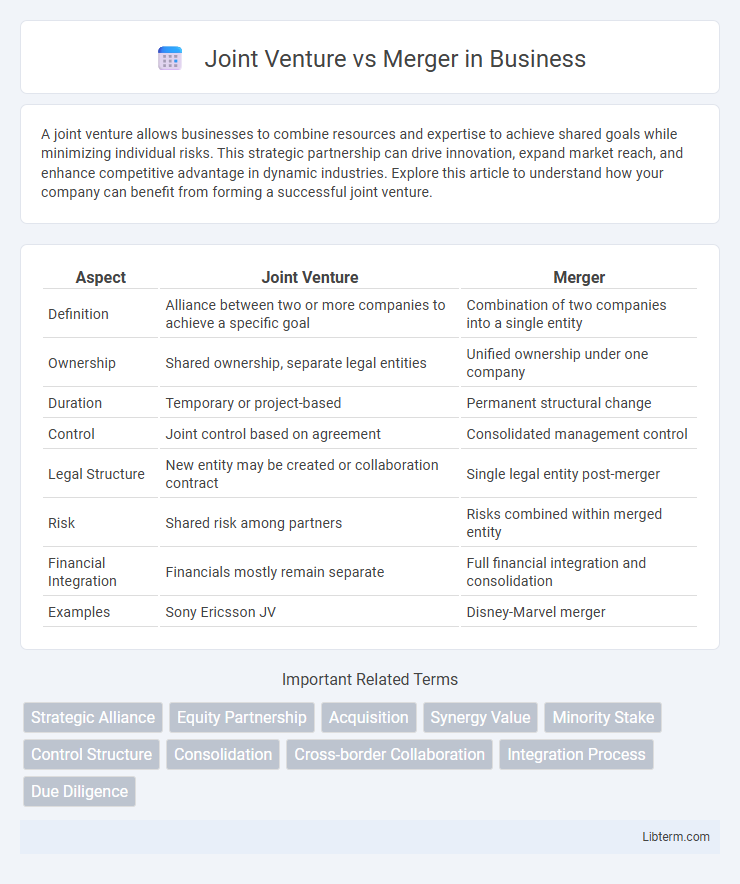A joint venture allows businesses to combine resources and expertise to achieve shared goals while minimizing individual risks. This strategic partnership can drive innovation, expand market reach, and enhance competitive advantage in dynamic industries. Explore this article to understand how your company can benefit from forming a successful joint venture.
Table of Comparison
| Aspect | Joint Venture | Merger |
|---|---|---|
| Definition | Alliance between two or more companies to achieve a specific goal | Combination of two companies into a single entity |
| Ownership | Shared ownership, separate legal entities | Unified ownership under one company |
| Duration | Temporary or project-based | Permanent structural change |
| Control | Joint control based on agreement | Consolidated management control |
| Legal Structure | New entity may be created or collaboration contract | Single legal entity post-merger |
| Risk | Shared risk among partners | Risks combined within merged entity |
| Financial Integration | Financials mostly remain separate | Full financial integration and consolidation |
| Examples | Sony Ericsson JV | Disney-Marvel merger |
Introduction to Joint Ventures and Mergers
Joint ventures involve two or more companies collaborating on a specific project while remaining independent entities, sharing resources, risks, and profits. Mergers combine two companies into a single legal entity, aiming to enhance market share, reduce competition, and achieve economies of scale. Understanding the differences between joint ventures and mergers is crucial for strategic business decisions regarding corporate growth and partnership structures.
Definitions: What is a Joint Venture?
A joint venture is a strategic partnership where two or more parties create a new, separate business entity to collaborate on specific projects or business activities while sharing ownership, risks, and profits. Unlike mergers, joint ventures allow the involved companies to retain their individual identities and operate independently outside the scope of the partnership. This arrangement is commonly used to combine resources and expertise for entering new markets or developing innovative products without fully integrating the businesses.
Definitions: What is a Merger?
A merger is a strategic business combination where two or more companies consolidate into a single legal entity, aiming to achieve synergies, expand market reach, and enhance competitive advantage. This process involves the absorption of one company by another or the creation of a new organization, with unified management and integrated operations. Unlike a joint venture, which is a temporary partnership for specific projects, a merger results in permanent unification of assets, liabilities, and corporate identities.
Key Differences Between Joint Ventures and Mergers
Joint ventures involve two or more companies collaborating on a specific project while remaining independent entities, whereas mergers combine companies into a single new entity with unified operations. Key differences include ownership structure, with joint ventures maintaining separate ownership and mergers transferring assets and liabilities to the new company. Financial integration differs as joint ventures share profits and losses based on contributions, while mergers consolidate financial statements and operations entirely.
Legal and Structural Considerations
Joint ventures involve creating a separate legal entity where parties share ownership, liabilities, and profits based on an agreement, allowing flexibility in governance structures tailored to specific projects. Mergers legally combine two or more companies into a single entity, leading to unified ownership, consolidated liabilities, and integrated management under one corporate structure. Legal considerations in joint ventures emphasize contract terms, exit strategies, and regulatory approvals, while mergers require comprehensive due diligence, shareholder consent, and compliance with antitrust laws.
Financial Implications and Funding Strategies
Joint ventures often require separate financial arrangements where partners contribute equity or secure joint financing, enabling shared risk and resource pooling without full consolidation on balance sheets. Mergers result in a single entity with combined assets and liabilities, necessitating comprehensive restructuring of capital, debt management, and unified accounting practices. Funding strategies in joint ventures focus on partnership-specific investment agreements, while mergers demand extensive due diligence to optimize capital structure and integration costs.
Risk Factors and Liabilities
Joint ventures limit risk exposure by confining liabilities to the agreed scope of the partnership, whereas mergers combine all assets and liabilities, amplifying potential financial and legal risks. In joint ventures, parties share specific project risks without inheriting each other's full liabilities, but mergers result in joint responsibility for all debts, contracts, and contingent liabilities. Evaluating risk factors requires analyzing the extent of liability assumption: joint ventures offer risk containment, while mergers integrate comprehensive liability profiles of both entities.
Strategic Advantages of Joint Ventures
Joint ventures enable companies to share resources, risks, and expertise while maintaining their independent identities, which enhances flexibility in pursuing market opportunities. They facilitate access to new markets and technologies without the complexities of full integration involved in mergers. Strategic alliances through joint ventures also promote innovation and local responsiveness by combining complementary strengths from each partner.
Strategic Benefits of Mergers
Mergers offer strategic benefits such as enhanced market share, increased operational efficiency, and access to new technologies and resources, enabling companies to achieve economies of scale and a stronger competitive position. They facilitate integrated decision-making and unified corporate culture, fostering innovation and long-term growth. Combining financial strength and diverse expertise through mergers often results in improved risk management and expanded global reach.
Choosing the Right Growth Strategy: JV vs Merger
Selecting between a joint venture and a merger hinges on business goals, resource commitment, and market expansion needs. Joint ventures offer strategic collaboration with shared risks and resources while maintaining separate identities, ideal for entering new markets or projects with limited commitment. Mergers consolidate entities into a single organization, providing full integration and control, suitable for companies aiming for complete synergy and long-term growth.
Joint Venture Infographic

 libterm.com
libterm.com